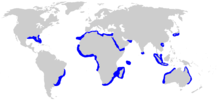| Carcharhinus brevipinna | |
|---|---|

| |
| Scientific classification | |
| Domain: | Eukaryota |
| Kingdom: | Animalia |
| Phylum: | Chordata |
| Class: | Chondrichthyes |
| Subclass: | Elasmobranchii |
| Order: | Carcharhiniformes |
| Family: | Carcharhinidae |
| Genus: | Carcharhinus |
| Species: | C. brevipinna
|
| Binomial name | |
| Carcharhinus brevipinna (J. P. Müller & Henle, 1839)
| |

| |
| Range of the spinner shark | |
| Synonyms | |
|
Aprionodon caparti Poll, 1951 | |
The spinner shark (Carcharhinus brevipinna) is a type of requiem shark, in the family Carcharhinidae, named for the spinning leaps it makes as a part of its feeding strategy. This species occurs in tropical and warm temperate waters worldwide, except for in the eastern Pacific Ocean. It is found from coastal to offshore habitats to a depth of 100 m (330 ft), though it prefers shallow water. The spinner shark resembles a larger version of the blacktip shark (C. limbatus), with a slender body, long snout, and black-marked fins. This species can be distinguished from the blacktip shark by the first dorsal fin, which has a different shape and is placed further back, and by the black tip on the anal fin (in adults only). It attains a maximum length of 3 m (9.8 ft).
Spinner sharks are swift and gregarious predators that feed on a wide variety of small bony fishes and cephalopods. When feeding on schools of forage fish, they speed vertically through the school while spinning on their axis, erupting from the water at the end. Like other members of its family, the spinner shark is viviparous, with females bearing litters of three to 20 young every other year. The young are born in shallow nursery areas near the coast, and are relatively fast-growing. This species is not usually dangerous to humans, but may become belligerent when excited by food. Spinner sharks are valued by commercial fisheries across their range for their meat, fins, liver oil, and skin. They are also esteemed as strong fighters by recreational fishers. The International Union for Conservation of Nature has assessed this species as Vulnerable worldwide.
- ^ Rigby, C.L.; Carlson, J.; Smart, J.J.; Pacoureau, N.; Herman, K.; Derrick, D.; Brown, E. (2020). "Carcharhinus brevipinna". IUCN Red List of Threatened Species. 2020: e.T39368A2908817. doi:10.2305/IUCN.UK.2020-3.RLTS.T39368A2908817.en. Retrieved 19 November 2021.
